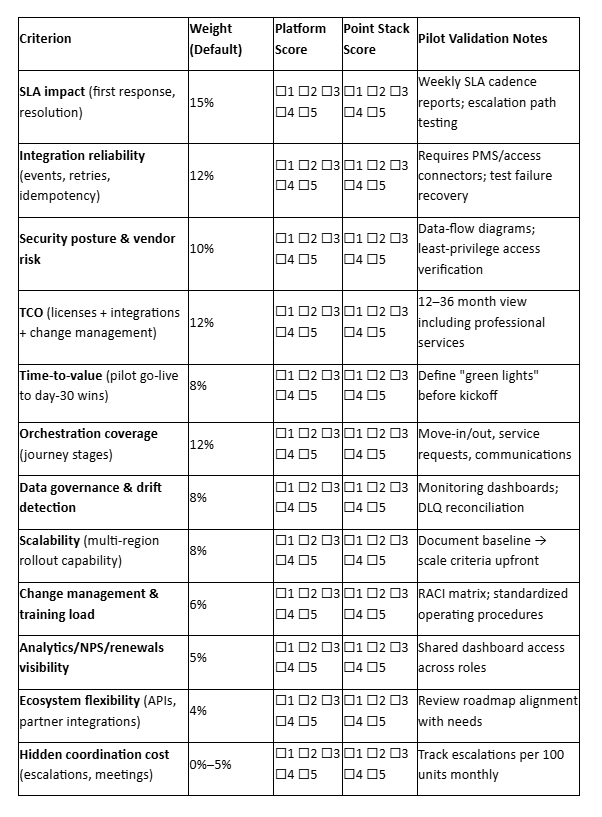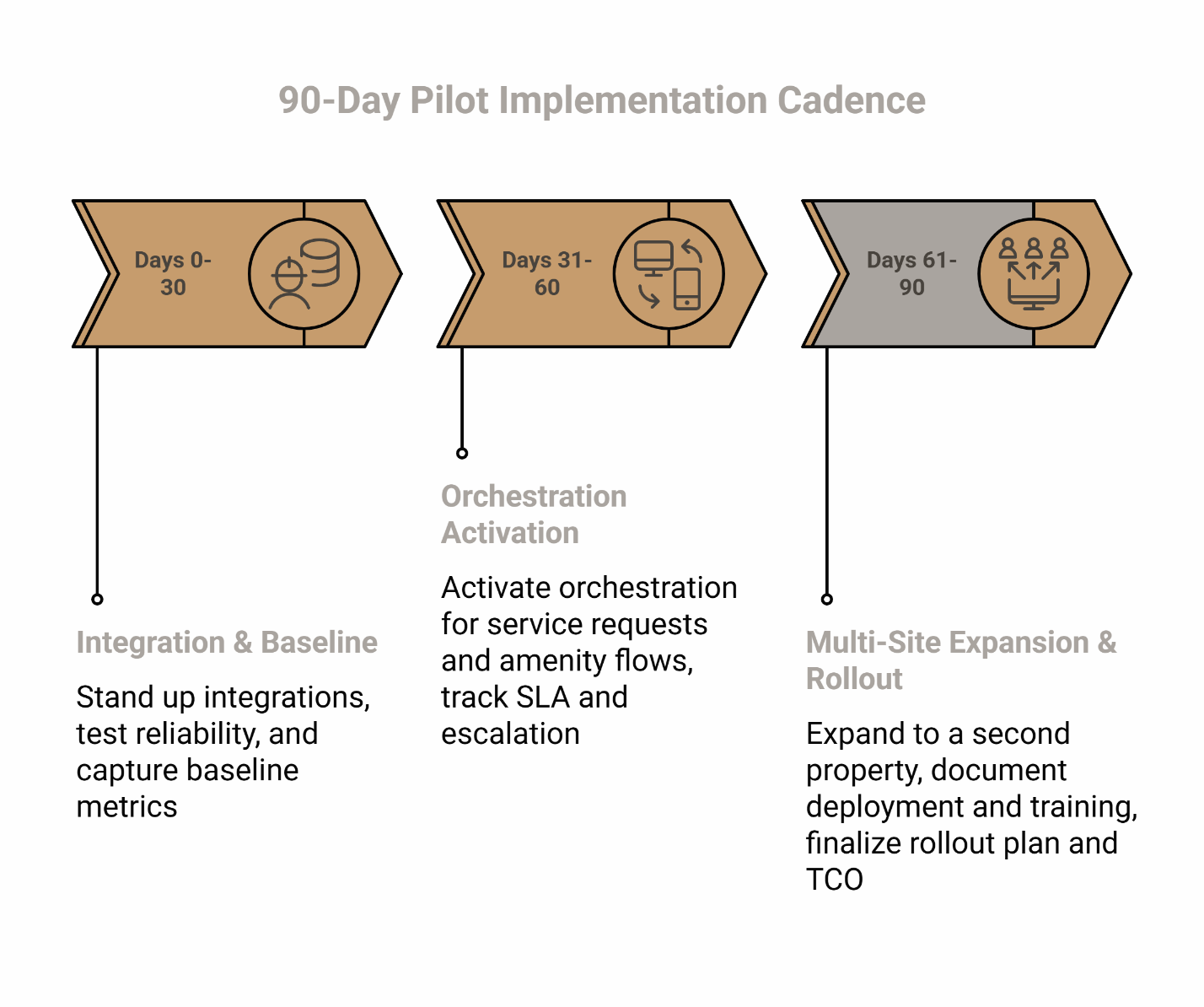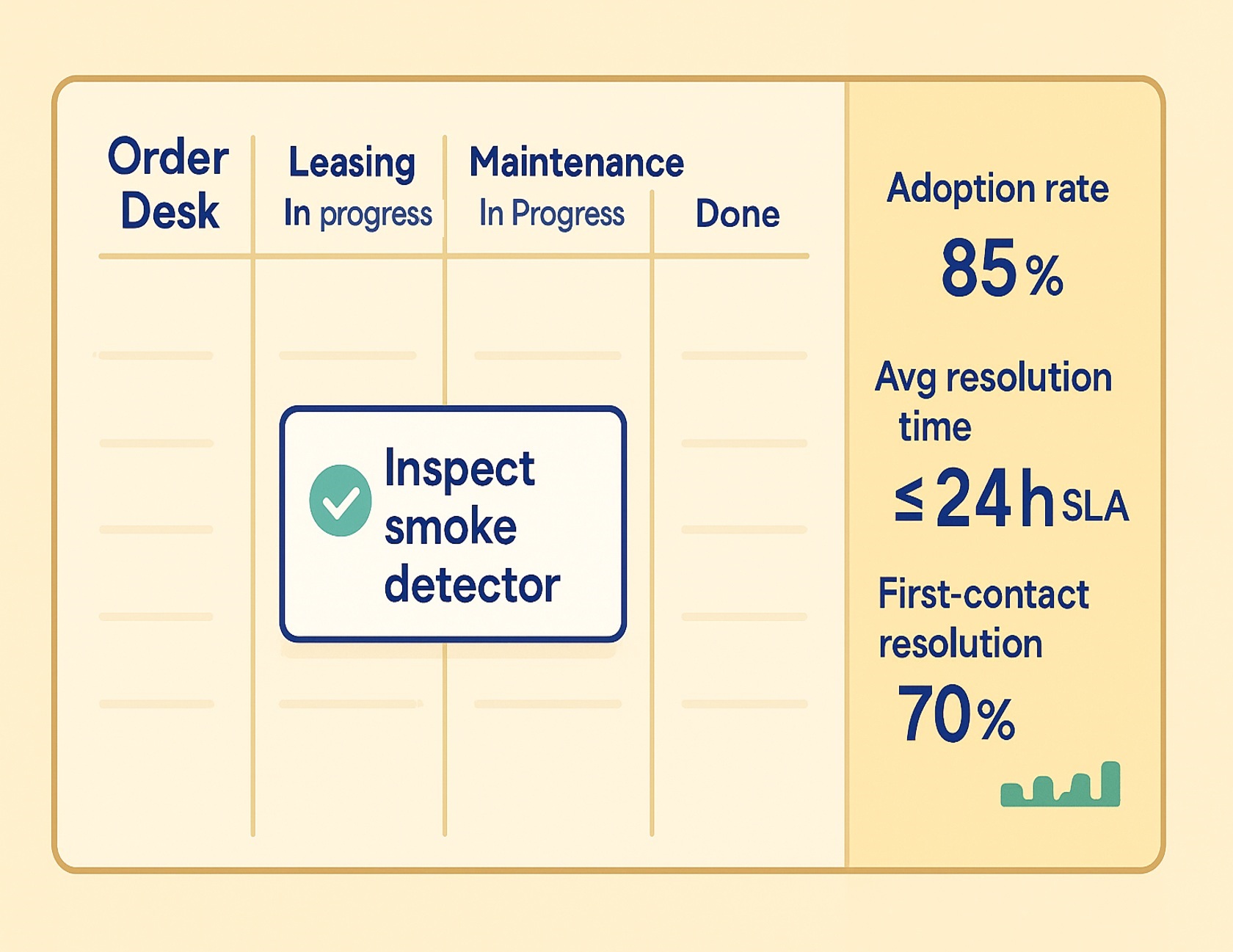
📌 Key Takeaways
Fragmented systems don't just slow workflows—they multiply escalations, erode SLAs, and force operational teams into endless coordination meetings that scale costs faster than portfolios.
- Coordination Trumps Features: Isolated point solutions with strong capabilities still fail when timing drift between systems creates SLA gaps and manual handoffs.
- Hidden Costs Compound at Scale: Escalation meetings, double-entry reconciliation, and vendor synchronization consume staff time that grows exponentially with each added tool.
- Pilots Prove Economics, Not Perfection: A 90-day validation with predefined success thresholds—SLA predictability, escalation reduction, staff adoption—prevents analysis paralysis and builds rollout confidence.
- Integration Reliability Gates Orchestration Value: Without idempotent event handling, retry logic, and DLQ monitoring in your PMS and access control foundation, workflow automation delivers inconsistent results.
- Score What Matters to Your Portfolio: Weight matrix criteria against your current pain points—if SLA misses dominate, integration reliability and orchestration coverage deserve higher priority than ecosystem flexibility.
Choose the architecture that reduces coordination tax, not the one with the longest feature list.
Regional Operations Directors managing Class A multifamily portfolios will find a decision-ready framework here, preparing them for the comparative analysis and pilot validation methodology that follows.
Move-in day at a 300-unit property. A new resident arrives to find their access credentials aren't synced, the welcome package missed critical details, and the first maintenance request disappears into a ticketing black hole. Three systems, three handoffs, three potential SLA failures—all before day one ends.
For Regional Operations Directors managing Class A multifamily portfolios, this scenario isn't hypothetical. It's the hidden cost of fragmented point solutions. The real question isn't whether individual features work—it's whether they coordinate reliably enough to deliver predictable resident experiences at scale.
Think of a resident experience platform as a control tower coordinating workflows across multiple systems. Integrations become the arteries delivering real-time events to the right team at the right moment. This guide provides a decision-ready matrix that weighs operational outcomes, risk profiles, and total cost of ownership. Use it to compare a unified platform with a stack of specialized tools, then validate your choice through a pilot that proves scale economics beyond license costs.
"Pilots measure confidence, not perfection."
What the Decision Really Hinges On

Outcomes flow from coordination, not isolated features. A maintenance app with a 15-minute response guarantee means nothing if the access control system doesn't notify the maintenance team when a unit becomes vacant. SLA misses often follow timing drift between systems—the gap between when one system completes an action and when the next system registers it.
Orchestration removes that drift by creating role-clear workflows with stateful handoffs. When a lease signing triggers in your property management software, a platform ensures the access system provisions credentials, the resident app delivers onboarding content, and the service desk opens a move-in checklist—all within seconds, not hours. Point solutions require manual coordination or custom integrations that become technical debt during your next vendor migration.
Comparative Decision Matrix
Instructions for use:
- Set criteria weights based on your portfolio's priorities (default percentages provided).
- Score both the Platform and Point Solution Stack from 1 to 5 for each criterion.
- Multiply each score by its weight, then sum to compare totals.
- Use a 90-day pilot to validate your top three risk assumptions before full rollout.
Note on technical terms: Idempotency means performing an operation multiple times produces the same result as performing it once—critical for preventing duplicate tickets or double-provisioned access. A DLQ (dead-letter queue) is a monitoring mechanism that captures failed events for inspection and retry, ensuring no workflow steps silently disappear.

Platform vs. Point Solutions—Pros & Cons
Resident Experience Platform Advantages:
- Orchestrated workflows create single source of truth for resident journey status
- Unified SLA visibility across all touchpoints reduces blind spots
- Lower coordination tax at scale—one integration layer instead of maintaining multiple custom connections
- Centralized data governance with built-in drift detection
Platform Considerations:
- Requires reliable integration foundation first (PMS and access control connectivity)
- Governance frameworks and change management processes need establishment upfront
- Initial implementation demands clear role definitions and workflow mapping
Point Solution Stack Advantages:
- Deep feature specialization in specific domains (maintenance, messaging, access)
- Perceived speed advantage for single-use-case deployments
- Flexibility to swap individual tools without replacing entire system
Point Solution Stack Considerations:
- Feature sprawl creates timing drift between systems, leading to SLA gaps
- Double-entry data management increases error rates
- Vendor risk spreads across multiple contracts and security audits
- Rising coordination cost—escalation meetings, manual reconciliation, status checks—grows with portfolio size
The Pilot Path
A 90-day pilot proves whether your chosen architecture delivers measurable improvements before you commit resources across your portfolio. Structure it with these elements:
Charter Components:
- Scope definition: Select 1-2 properties representing your operational complexity
- Leading indicators: Response time improvements, escalation reduction, resident NPS lift
- Role clarity: Define who owns each workflow stage and handoff point
- Risk documentation: Identify your top three assumptions to validate (often integration reliability, staff adoption rate, and SLA predictability)

30/60/90 Day Cadence:
Days 0-30: Stand up integrations and confirm technical reliability. Test idempotent event handling, retry mechanisms, and DLQ monitoring to ensure no workflow steps fail silently. Capture your "green lights"—baseline metrics like move-in workflow completion rate and first-response time—that signal readiness for broader rollout.
Days 31-60: Activate orchestration for service requests and amenity flows. Track SLA predictability week over week and measure escalation count per 100 units. This phase reveals whether coordination improvements translate to staff efficiency gains.
Days 61-90: Expand to a second property to validate multi-site scalability. Document deployment time, training hours per role, and any configuration drift between properties. Finalize your rollout plan and complete the TCO model that includes licenses, integration services, and ongoing change management.
Scale Criteria: Document these before your pilot begins to avoid analysis paralysis later. What SLA improvement justifies broader rollout? What escalation reduction rate proves coordination value? What staff feedback signals adoption success? Without predefined thresholds, pilots stall in endless evaluation.
The most common failure mode isn't technical—it's launching without clear success metrics, then debating whether results justify expansion.
Frequently Asked Questions
Can we mix a platform with a few specialized point tools?
Yes, provided the platform serves as the orchestration layer. Many operators use a resident engagement platform to coordinate workflows while maintaining specialized tools for specific functions like amenity management. The key requirement is clear data ownership—one system must be the source of truth for each data element to prevent drift.
How do we quantify hidden coordination cost?
Track escalations per 100 units monthly. Count how many times your team needs manual intervention because systems didn't communicate—missed move-in packets, access credential delays, service requests routed to wrong teams. Multiply by average staff time to resolve (typically 15-30 minutes) and your blended labor rate. For broader context on how collaboration overhead affects operational efficiency, Harvard Business Review has published extensive research on the hidden costs of cross-functional coordination. In our experience with operations teams, this cost often exceeds the price difference between architectures within 12 months at portfolios above 500 units.
What's the minimum integration scope to start?
Your property management system and access control system form the foundation. Without reliable PMS integration, resident data lacks a single source of truth. Without access control connectivity, move-in orchestration fails at the most visible moment. These integrations must support idempotent event handling and retry logic—for technical background, see Martin Fowler's distributed systems patterns and AWS documentation on implementing dead-letter queues. Additional integrations (maintenance systems, communication platforms) deliver incremental value but aren't prerequisites for initial deployment.
What does Finance need versus Operations for sign-off?
Finance typically requires a 12-36 month TCO model that includes not just license costs but integration services, change management, and the opportunity cost of coordination time. Operations leadership needs evidence that SLA improvements are measurable and sustainable—hence the pilot-first approach. IT stakeholders focus on security posture, vendor risk distribution, and whether the architecture reduces or increases their technical debt. Security artifacts like data-flow diagrams and least-privilege access models help all stakeholders evaluate risk. For broader security framework context, ISO/IEC 27001 provides industry-standard guidelines.
Make the Choice That Reduces Escalations
The decision between a resident experience platform and a point solution stack ultimately determines whether your team spends time coordinating systems or improving resident outcomes. Feature completeness matters, but coordination reliability predicts whether those features deliver consistent experiences.
Use the matrix above to score both options against your portfolio's priorities. Weight heavily the criteria that directly impact your current pain points—if SLA misses are your primary challenge, integration reliability and orchestration coverage deserve higher weights than ecosystem flexibility.
Then validate your choice through a disciplined pilot. Measure what matters: response time consistency, escalation frequency, staff time spent on manual coordination. Let evidence, not vendor promises, guide your final decision.
Ready to scope a pilot that proves scale economics? Book a demo to map your specific workflows and integration requirements.
Disclaimer: This guide provides a framework for evaluating architectural decisions in multifamily operations. Your specific requirements may vary based on portfolio size, technology stack, and operational model. Use this matrix as a starting point for internal discussions, not as a replacement for thorough vendor evaluation and pilot validation.
About the Author: The ElevateOS Insights Team is our dedicated engine for synthesizing complex topics into clear, helpful guides. While our content is thoroughly reviewed for clarity and accuracy, it is for informational purposes and should not replace professional advice.

.avif)


